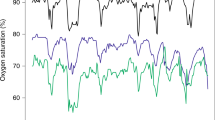Abstract
Background
A pilot investigation was undertaken to assess the performance of a novel fiber-optic cerebral pulse oximetry system. A fiber-optic probe designed to pass through the lumen of a cranial bolt of the type used to make intracranial pressure measurements was used to obtain optical reflectance signals directly from brain tissue.
Methods
Short-duration measurements were made in six patients undergoing neurosurgery. These were followed by a longer duration measurement in a patient recovering from an intracerebral hematoma. Estimations of cerebral arterial oxygen saturation derived from a frequency domain-based algorithm are compared with simultaneous pulse oximetry (SpO2) and hemoximeter (SaO2) blood samples.
Results
The short-duration measurements showed that reliable photoplethysmographic signals could be obtained from the brain tissue. In the long-duration study, the mean (±SD) difference between cerebral oxygen saturation (ScaO2) and finger SpO2 (in saturation units) was −7.47(±3.4)%. The mean (±SD) difference between ScaO2 and blood SaO2 was −7.37(±2.8)%.
Conclusions
This pilot study demonstrated that arterial oxygen saturation may be estimated from brain tissue via a fiber-optic pulse oximeter used in conjunction with a cranial bolt. Further studies are needed to confirm the clinical utility of the technique.






Similar content being viewed by others
References
Hinds CJ, Watson JD. Intensive care: a concise textbook. 3rd ed. London: Saunders Ltd.; 2008.
Marik PE, Varon J, Trask T. Management of head trauma. Chest. 2002;122(2):699–711.
Graham DI, Adams JH, Doyle D, et al. Ischaemic brain damage os still common in fatal non-missile head injury. J Neurol Neurosurg Psychiatry. 1989;52:346–50.
Bartlett J, Kett-White R, Mendelow AD, Miller JD, Pickard J, Teasdale G. Guidelines for the initial management of head injuries: recommendations from the Society of British Neurological Surgeons. Br J Neurosurg. 1998;12:349–52.
Chesnut RM, Marshall LF, Klauber MR, et al. The role of secondary brain injury in determining outcome from severe head injury. Journal of Trauma. 1993;34:216–22.
Valadka AB, Gopinath SP, Contant CF, Uzura M, Robertson CS. Relationship of brain tissue PO2 to outcome after severe head injury. Crit Care Med. 1998;26(9):1576–81.
Schell RM, Cole DJ. Cerebral monitoring: jugular venous oximetry. Anesth Analg. 2000;90(3):559–66.
Kirkpatrick PJ. Use of near-infrared spectroscopy in the adult. Philos Trans R Soc Lond B. 1997;352(1354):701–5.
Ferrari M, Mottola L, Quaresima V. Principles, techniques, and limitations of near infrared spectroscopy. Can J Appl Physiol. 2004;29(4):463–87.
Hiraoka M, Firbank M, Essenpreis M, et al. A Monte Carlo investigation of optical pathlength in inhomogeneous tissue and its application to near-infrared spectroscopy. Phys Med Biol. 1993;38(12):1859–76.
Germon TJ, Kane NM, Manara AR, Nelson RJ. Near-infrared spectroscopy in adults: effects of extracranial ischaemia and intracranial hypoxia on estimation of cerebral oxygenation. Br J Anaesth. 1994;73(4):503–6.
Germon TJ, Young AE, Manara AR, Nelson RJ. Extracerebral absorption of near infrared light influences the detection of increased cerebral oxygenation monitored by near infrared spectroscopy. J Neurol Neurosurg Psychiatry. 1995;58(4):477–9.
van den Brink WA, Haitsma IK, Avezaat CJ, Houtsmuller AB, Kros JM, Maas AI. Brain parenchyma/pO2 catheter interface: a histopathological study in the rat. J Neurotrauma. 1998;15(10):813–24.
Phillips JP, Kyriacou PA, George KJ, Priestley JV, Langford RM. An optical fiber photoplethysmographic system for central nervous system tissue. In: Conference Proceedings of Annual International Conference of the IEEE Engineering in Medicine & Biology Society, vol. 1, p. 803–6, 2006.
Mortara RW. Intracranial pressure monitoring in the emergency setting. Med Instrum. 1982;16(4):197–8.
Ghajar J. Intracranial pressure monitoring techniques. New Horizons. 1995;3(3):395–9.
Barash PG, Cullen BF, Stoelting RK. Clinical anesthesia. 5th ed. Philadelphia: Lippincott Williams and Wilkins; 2006.
Phillips JP, Langford RM, Kyriacou PA, Jones DP. Preliminary evaluation of a new fibre-optic cerebral oximetry system. Physiol Meas. 2008;29(12):1383–96.
Moyle J. Pulse oximetry (principles and practice). 2nd ed. London: BMJ Books; 2002.
Szold A, Pizov R, Segal E, Perel A. The effect of tidal volume and intravascular volume state on systolic pressure variation in ventilated dogs. Intensive Care Med. 1989;15(6):368–71.
Author information
Authors and Affiliations
Corresponding author
Electronic supplementary material
Below is the link to the electronic supplementary material.
Rights and permissions
About this article
Cite this article
Phillips, J.P., Langford, R.M., Chang, S.H. et al. Cerebral Arterial Oxygen Saturation Measurements Using a Fiber-Optic Pulse Oximeter. Neurocrit Care 13, 278–285 (2010). https://doi.org/10.1007/s12028-010-9349-y
Published:
Issue Date:
DOI: https://doi.org/10.1007/s12028-010-9349-y




